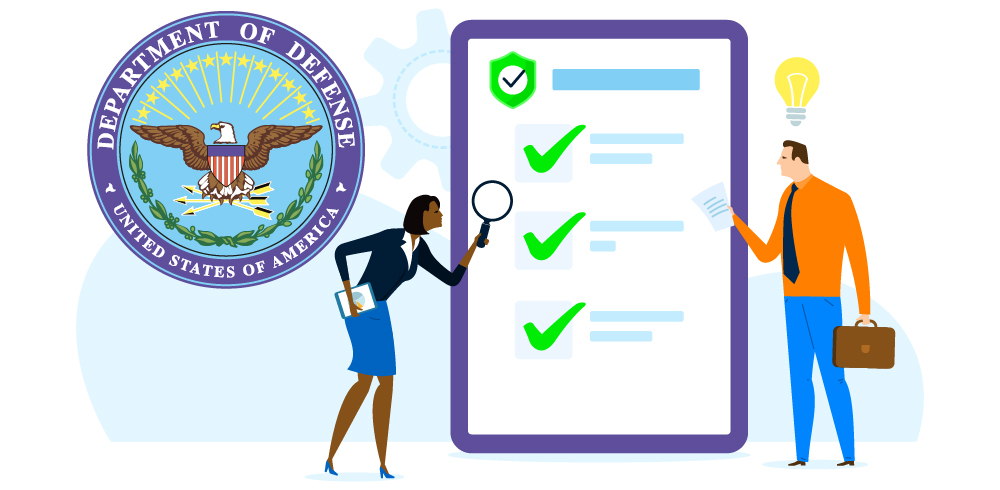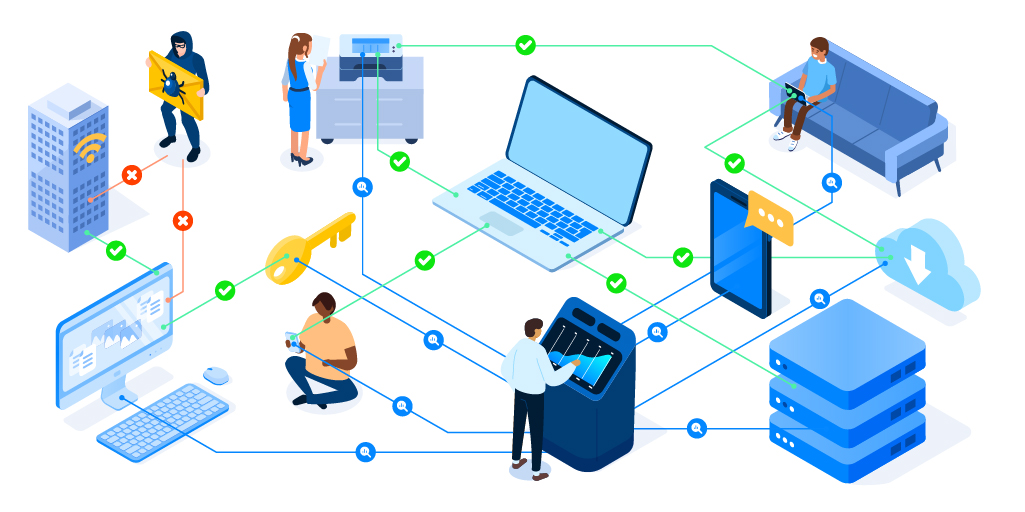The US Department of Defense Zero Trust strategy means increased security across all government bodies by giving no inherent trust to any user accessing apps, networks, or systems. The DoD Zero Trust strategy enables the transition from static, network-based security to a more dynamic collection of cybersecurity practices.
Read on to find out what a successful DoD Zero Trust implementation is and why adding continuous authentication on all of your endpoints will help you achieve Zero Trust.
Table of contents:
- What is the Department of Defense Zero Trust?
- The context for the DoD’s Zero Trust strategy
- Who is impacted by the Department of Defense Zero Trust strategy?
- What are the 3 key factors in successful DoD Zero Trust implementation?
- How does the federal Zero trust strategy increase cybersecurity capabilities through its 7 pillars?
- Why continuous authentication is key to Zero Trust?
- How does ActiveLock help you comply with DOD Zero trust?

What is the Department of Defense (DoD) Zero Trust?
The core principle of the Department of Defense Zero Trust strategy is a paradigm shift from “trust but verify” to “never trust, always verify”. Due to increased hybrid cloud usage, remote work habits, and advanced cyber threats, public and private organizations can no longer avoid a Zero Trust approach to data protection.
Organizations are transitioning to a hybrid cloud and discovering more about the security risks deemed less important or unknown before the paradigm change. For example, when your workforce is remote, do you really know who the person behind your organization’s endpoint is? What if your employees’ work device was lost, stolen, or innocently shared with unauthorized users like friends and family? What about where your sensitive data is in a hybrid cloud deployment? The list goes on and on.
A Zero Trust strategy for data protection is essential because it allows enterprises to no longer offer implicit trust to users, network locations, and devices. Instead, all data access requests are considered hostile, regardless of whether they come from within or outside an organization. Zero Trust allows users and devices to safely access data, apps, and resources, by ensuring continuous authentication, authorization, and regular validation.
But, before diving deeper into the main points of Zero Trust, let’s look at why US officials have also appreciated that enterprises can no longer avoid Zero Trust and how this decision impacts the state administration and private corporations alike.
The context for the DoD’s Zero Trust strategy
Last year’s White House Executive Order (EO) 14028 on cybersecurity required federal agencies to begin transitioning to a zero-trust architecture (ZTA), which will allow increased security across federal systems and limit the risk of cyber attacks and security incidents.
The official DoD’s Zero Trust Strategy was recently published in November 2022 and provides the means to improve the implementation of its earliest versions, such as the Zero Trust Reference Architecture published in July 2022. Both the strategy and the reference architecture aim to complement the cybersecurity Executive Order 14028 with specific steps for DoD components and their vendors.
By 2027, all DoD organizations must implement zero trust. To help federal bodies and contractors align with the enterprise-wide strategy, on November 15, 2022, DoD put forward a Zero Trust Capability Execution Roadmap, which establishes baseline capabilities and activities to achieve Target and Advanced Zero Trust levels on each of the strategy’s 7 pillars.
“What we’re aiming for by 2027 is to have zero trust deployed across a majority of our enterprise systems. That’s an ambitious goal, but the adversary capability we’re facing leaves us no choice but to move at that pace.”
John Sherman, DoD’s CIO
Who is impacted by the Department of Defense Zero Trust strategy?
Although the Department of Defense Zero Trust strategy and requirements are created for deployment within the government, the trend to increase security is also relevant in the private sector. With increased cyber threats, corporations and private organizations who work with or provide services to the federal government have much to learn from the strategy and must abide by its rules if they wish to partner and collaborate with government bodies.

What are the 3 key factors in successful DoD Zero Trust implementation?
As the DoD is working hard to be a leader in Zero Trust adoption among the federal government and its contractors, their plan will, of course, need some adjustments and will not be a perfect fit for everyone. However, there are 3 key paths for the successful implementation of the strategy within any organization:
1. Workforce Zero Trust
Workforce Zero Trust is about ensuring that only authorized users and, respectively, only authorized secure devices gain access to enterprise applications, networks, and systems, regardless of the user’s location. The best way to achieve this is by deploying continuous authentication across all corporate or government-owned devices to ensure that only the people you trust, such as employees, contractors, partners, or vendors, are accessing your data. Find out more about how to reach zero trust goals with continuous authentication.
2. Workloads Zero Trust
The workloads zero trust pillar focuses on safe access and protecting workloads as they move through cloud environments. Strong security practices are key, especially when an application’s database is accessed via an API, microservice, or container that operates in virtualized contexts, such as private clouds.
3. Workplace Zero Trust
The workplace zero trust pillar concentrates on secure access for all devices, including Internet of Things (IoT) devices, that connect to business networks, including but not limited to:
- User endpoints,
- Physical and virtual servers,
- Printers,
- Cameras,
- HVAC systems,
- Kiosks,
- Industrial control systems.

How does the federal Zero Trust strategy increase cybersecurity capabilities through its seven pillars?
The federal DoD Zero Trust strategy highlights seven Pillars to help categorize the capabilities and technologies required to perform Zero Trust functions. These 7 pillars are associated with an interconnected group of strategic resources which are bound together in a Zero Trust Framework as follows:
- User
- Device
- Network & Environment
- Applications & Workloads
- Data
- Visibility and Analytics
- Automation and Orchestration
Why is continuous authentication key to DoD Zero Trust Strategy?
Under “User,” which is the first pillar of the DoD strategy, it’s explained that you should never trust a user, even after they have first logged in to a system using their credentials. That a user should still be viewed as a potential threat throughout their entire interaction with a network.
By validating the identity of users non-stop, continuous authentication works as the main component of “never trust, always verify,” which is the foundation of a Zero Trust architecture. According to the Department of Defense Zero Trust Reference Architecture Version 2.0, published in July 2022, the operational definition of Continuous Authentication is “the ability to validate network users are the ones who they claim to be throughout an entire session at every step.”
A big component of any continuous authentication approach is behavioral biometrics, which involves “observing activities of users, information systems, and processes and measuring the activities against organizational policies and rules, baselines of normal activity, thresholds, and trends.”
How does ActiveLock help you comply with DoD Zero Trust?
ActiveLock is an AI-based continuous endpoint authentication (CEA) application that allows any large or small enterprise to enforce Zero Trust efficiently and effectively throughout all their endpoints.
As we mentioned above, one of the key principles of Zero Trust is “never trust, always verify.” What this means is that even after a user is granted access to a system, their interaction and activity should be continuously monitored, and their identity should be continuously verified in order to prevent any potential breaches and detect suspicious behavior.
ActiveLock locks out potential intruders by continuously verifying the user’s identity behind enterprise computers based on their typing behavior. Simply put, the IT team installs ActiveLock on all enterprise devices, and a typing biometrics profile is created for each authorized user linked to each authorized device. In the event of the company device being shared with– surprisingly dangerous–insider threats like friends and family, or if the endpoint is stolen and manipulated by malicious hackers, ActiveLock will recognize that the typing pattern fails to match the registered owner of the device, and trigger a silent alert to the security team — signaling that there is a high risk that an unauthorized user has taken over. For an added layer of security, employers can even choose to have ActiveLock lock that computer to protect all data found on it and prevent any unauthorized party from accessing the enterprise network, systems, and applications.
Get your free ActiveLock license to see firsthand how continuous authentication helps you achieve Zero Trust.

